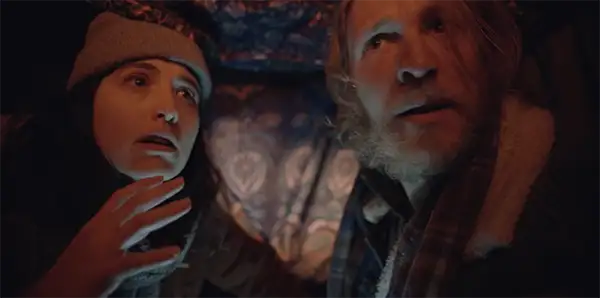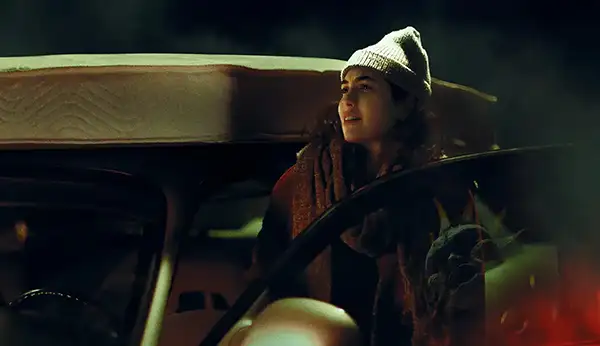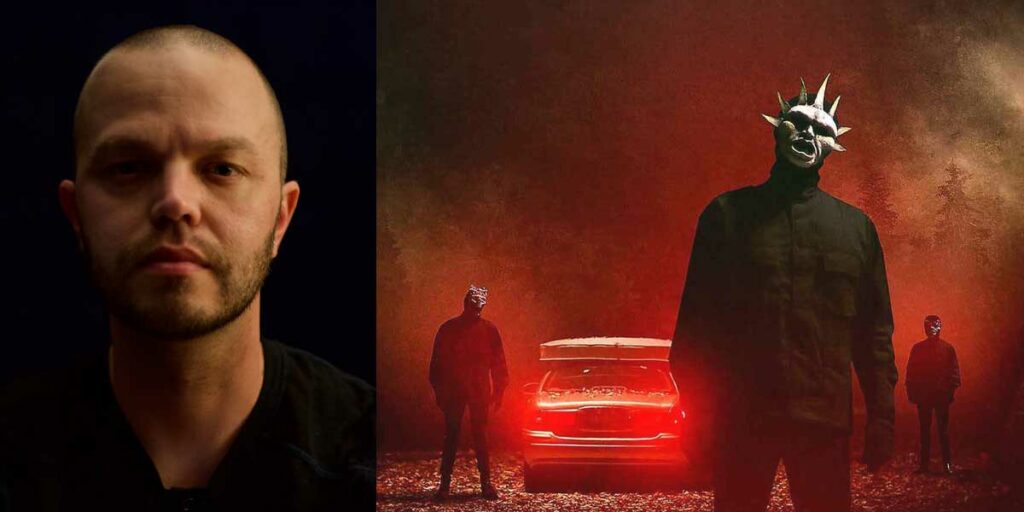We interview director Jason Miller about his feature debut, Ghosts of the Void, a masterful suspense thriller that stems from a dark reality.
Jason Miller debuts his first feature film Ghosts of the Void, and immerses his audience in the intricacies of Jen (Tedra Millan) and Tyler’s (Michael Reagan) complicated relationship unraveling on one fateful night of their lives, which they must spend inside their car after being forced out of their home. They park in a desolated part of town, engulfed in the darkness of the woods, looking to spend a quiet night before facing tomorrow’s adversities. However, the built-up tension begins to slip through the cracks while sinister strangers lurk in the shadows with mysterious motives towards the couple.
Without spoiling anything, Ghosts of the Void roots itself in a somber reality and a circumstance dangerously plausible. That’s what makes it so terrifying: how it portrays a dark internal feeling you seldom see depicted on screen so truthfully, and the way that feeling can fester within you, grow uncontrollably, and manifest in ways you can’t imagine.
A few days prior to the film’s digital release, we gathered over Zoom with the writer and director of Ghosts of the Void, Jason Miller, to learn more about his creative vision and process, his experience, and his inspirations. Read the interview below!
The Development Process: How Jason Miller Shaped Ghosts of the Void
How much of the story did you already have when you started writing? And how much of it came together as you were writing?
Jason Miller: Most of it came together while I was writing. That’s typically how I approach stories. It’s the Stephen King method of starting with a single idea, a “what if”, and seeing where it goes. The initial idea was that of two people living in their car, and something happens to them, which would have made it a horror film. The very first draft I wrote was quite a bit different than the version that we got on screen. It was very surrealist.
I kept the whole thing in the car, but I wanted to see what happens if I take it on a more traditional thriller route. So, I pulled the script back up, started from page one, same setup, but this time, I decided to see what happens if there’s an actual antagonist. I think we ended up somewhere in the middle, because the psychology of the anxiety a person can feel under that kind of stress was much more interesting to me. I worked back in some of the surrealist elements from the first draft. That’s when we landed on the film that we shot.

Originally, it was supposed to be all inside the car?
J.M.: Yeah, it was. And it was very passive, which is one of the reasons I think I chunked that version. It was mostly her observing things happening around her. She gets involved a little bit, but it was very challenging to keep that going.
With all of it being shot in one location (besides flashbacks), I can imagine there was one less thing to worry about when it comes to making the film happen. How long did the shooting process take you in general? Was it full-night shoots?
J.M.: Full-night shoots for, I want to say, 19 nights. We did one day shoot, which is when we shot all our flashbacks. This was in November in a suburb outside of Chicago. It was freezing cold and pitch black. It was rough. The idea of making a film like this is, you want to keep it this low-budget, minimalist kind of thing, with one location and a couple of characters. My mistake was that I made that one location a dark parking lot in the middle of the night. So it didn’t really pay off in terms of the ease, but, you know, we still liked the story. So we stuck with it.
This is your first feature film. I’m sure there’s quite a lot of pressure that comes with that in terms of figuring out what you want to say with your first feature. I personally think you knocked it out of the park! When was the moment you knew you were onto something, and that this was going to be what you were going to make for your first feature-length work?
J.M.: I think it was the moment I believed in the premise. This film is very thematic, so much so that one might assume I started from the point of wanting to make some kind of statement. And I didn’t, really. I just wanted to tell a story about two people stuck in a car and some kind of horror story that happens around that. But once I had the idea that they were living in their car and evicted, which was pretty much right away, I realized I couldn’t tell that story without touching on the themes around the struggle.
I’ve never lived out of my car, it’s never gotten that far for me, but there was a period of my life out of college where I was trying to find work, and when you don’t know how you’re going to pay your rent, that anxiety really builds up. I knew I had to incorporate all the details of that experience into this story—the way they approach problems and the way that they think about their situation. I wanted to make sure that was very specifically accurate to how I felt about that experience. Once I was going down that road, I said to myself, “this is the story I need to write now. This is the most meaningful thing I have in development at the moment”. So I ran with it, and I knew that was going to be the first feature.
The Character-Driven Narrative: Building Jen and Tyler
I’m a sucker for character-driven stories. With so much emphasis on the relationship being the heart of why everything unravels, tell me more about how you built that. What even is the starting point of creating such a complicated relationship?
Jason Miller: I start from the premise and just see where it goes. To really do that successfully, you have to let the characters lead it, because they’re the ones making the choices that drive the story forward. I’m not plotting it out, I’ll just throw in an event and let them respond to it. Piece by piece, you start adding little elements to their story: How did they get here? What secret feelings do they harbor against each other? How might that come out? Then, you hire really good actors to bring those characters to life, and they pick up the ball from there. I was very fortunate: I think Michael and Tedra embody those characters and did a lot with them.
What were you looking for in the actors that were going to portray Jen and Tyler? How did you find them?J.M.: We cast them through a Chicago-based agency: they were the best ones for what I was looking for. For Jen, I was looking for strength but also vulnerability. She needed to be able to convey a lot of stress and having a lot of weight on her shoulders, but also be able to go from coping with that to not coping with that. With Tyler, I was looking for that ability to switch back and forth between charming and friendly and harboring these darker tendencies. And Michael was really able to tap into that.
The Supernatural Ambiguity in Ghosts of the Void
You said an earlier draft of the film had more of the surrealist supernatural. How do you think the supernatural element amplifies the story?
Jason Miller: I think of it more as psychological: the anxiety and the stress. There are many sleepless nights just laying in bed thinking about what I am going to do tomorrow and when the rent comes in. You spend enough sleepless nights, and you start to lose it. You start to build up this idea that the world’s out to get you. I wanted people who watched this movie to feel the anxiety that I felt. It was going to be like an experience in that regard, not necessarily to be analyzed so closely that you’re trying to break down what’s real and what’s not.

*****WARNING: The following question includes spoilers and allusions to the film’s ending*****
I want to talk to you about the third act, when the supernatural just lets loose. I believe the people with the masks were, in a way, manifestations of Jen’s intense anxieties and her way of coping with what had actually happened and what she had actually done. What was your thought process behind taking the movie to that extreme emotional place for Jen? It really takes a lot for a person to get to that point. What do you wish for people to get out of it when they experience the tragic downfall of the relationship?
J.M.: It felt like the direction that it needed to go. I tried a couple of different endings, I tried happier endings, it just didn’t resonate. The movie had to come down to this relationship. I had been alluding to this idea that Jen kind of resents Tyler and feels like he’s responsible, and that if she can just get away from this life, she might be able to make things happen for herself. I knew that the third act had to be about that ultimate confrontation. It came down to her making the choice that was a non-choice, the choice not to do something that she could and accept that as her reality. There’s a lot people could take away from it in terms of our culture and our social climate. The main thing being that none of this had to happen.
In many ways, this is a movie about mental illness and how stress and anxiety can influence that. Jen and Tyler mention they had help at one point, they had therapy, they were on medication, but they lost their insurance, and that goes away. So they resort to helping each other and self-medicating. They become codependent. I would like people to look at the mundane reality of this. The ending is probably the scariest part, so much of this was avoidable if they had just been taking care of themselves a little better. I think if there’s any real statement being made, in the end, it would be something to that effect.
Jason Miller’s loud voice in the quietness of Ghosts of the Void
Is genre important to you as a filmmaker? Does it help you shape your vision? Or do you think it hinders it more?
Jason Miller: I tend to think of genre as a tool within your storytelling. So I don’t necessarily feel like I have to stick strictly to certain rules of genre. But I do love horror. And I knew I wanted to make a horror thriller film. But starting from such a simple place, by definition, it had to be character-driven, exploring who these characters were, and so the drama starts coming out before the horror ever does. I might be misquoting, but I think it was C. Robert Cargill on Twitter who said a good premise for a horror film should have the potential to not be a horror film. For Ghosts of the Void, I could have decided 20 pages in that it’s going to be this mumblecore drama of two people hashing out their issues in a car, but instead, I started incorporating horror elements. One approach to genre is, “Could your setup take a different direction?” I think you get an interesting dynamic when you approach it that way, not that it always has to be approached that way. I’m writing a script now that starts horror and stays horror.
Did you have any inspiration for visual style? Any filmmakers that you look up to?
J.M.: I don’t know if I could pinpoint any one thing visually. My DP (Nathan Salter) and I talked about leaning into some retro aspects. There are a couple of zoom shots, and he was using some vintage lenses. I have an unconscious old-school tendency for how I approach things like blocking and the visuals, based on the films that I grew up watching. In terms of my approach to slow-burn in general, there’s a couple of movies that I kept going back to. One specifically was The House of the Devil by Ti West, or any Ti West movie, because he is such a master at the slow burn. I did look a lot at its structure and pacing to figure out how far I could take the slow-burn aspect of it. How slow can I really make it? I don’t know if it influenced the visuals as much as the general structure and vibe.
Last question! What was one of the biggest lessons you took away and something that you learned that you will carry over into your future work?
J.M.: Oh, that’s a good one. There’s a lot to unpack, because there was so much that I had to wrestle with to get this movie made. I don’t know if I learned as much as I relearned and re-confirmed things that I knew but had let go. Mainly, plan, plan, plan, prepare, you’ve got to prepare and be flexible a lot. Going into my next film, certainly, I will make a lot less assumptions about what’s going to happen on the day and be a lot more anal about making sure that things are in place when we get there. You get under the stress of it all, and you start getting a little lazy with some things until you realize there are rules for a reason.
This interview was edited for length and clarity.
Ghosts of the Void is now available to watch on digital and on demand.

